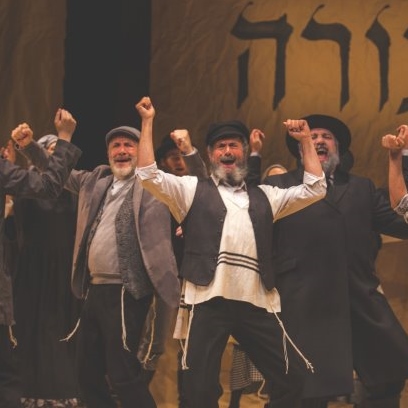
Featured Item

Yiddish alive and well amongst international Jewry
TALI FEINBERG
Jennifer Young of the YIVO Institute for Jewish Research argues that we should not be talking about a rebirth of Yiddish, but a living language. “Let’s get one thing straight, Yiddish is not a dying language. While UNESCO [the United Nations Educational, Scientific, and Cultural Organisation] officially classifies Yiddish as an ‘endangered’ language in Europe, its status in New York is hardly in doubt,” she writes.
“According to some estimates, Yiddish is the fifth most commonly spoken language in Brooklyn, behind English, Spanish, Russian, and Chinese. In the Brooklyn neighbourhoods of Williamsburg and Borough Park alone, the number of Chassidic Jews for whom Yiddish is the primary language is well over 150 000. While census data on Yiddish is notoriously skewed [census numbers do not include speakers under five years of age, a major Chassidic demographic], the numbers indicate that Yiddish is here to stay. Even UNESCO recently held a conference titled, ‘The Permanence of Yiddish’.
“While Yiddish is no longer the language of secular mass culture, its current ‘post-vernacular’ status among non-Chassidic Jews means that the people who engage with Yiddish do so not as passive consumers, but as active builders of their own communities,” she says.
Indeed, in New York, the musical Fiddler on the Roof has just hit Broadway. In Massachusetts, the National Yiddish Book Center has a repository of more than a million volumes and national membership of about 30 000 people. In Chicago, at a screening of Yiddish film Leah, Teddy & the Mandolin last year, one viewer’s response was, “Yiddish is our collective soul.”
In Cape Town, an archive of Yiddish music is stored at Stellenbosch University, a Yiddish Song Festival played to acclaim for ten tears, and a Yiddish language course has added another workshop to its calendar as the thirst for learning the language continues unabated. It appears that interest in the “lost” language of Yiddish is growing around the world – but why?
Aaron Lansky, the founder of the National Yiddish Book Center, told Harvard Review that interest in the language – for scholarly reasons, nostalgia, ethnic pride, or connection to a half-forgotten past – is greater than ever. As evidence, he points to the enthusiasm for Klezmer music, Yiddish theatre, and vintage films, in addition to his own enterprise.
The Guardian reports that beyond the very religious, Yiddish has been undergoing a marked revival, especially among young people, for more than 20 years. There are reportedly more than 100 colleges and universities around the world teaching Yiddish.
“The main driver of this revival is the fact that as Jewish populations become more diverse and Jewish identity less connected to religion and more to ethnicity, Jews are increasingly looking for alternative ways to be Jewish,” writes Antony Lerman.
“It’s common now to flesh out an alternative Jewish identity with a passion for Klezmer, an interest in Yiddish theatre, novels, poetry, and films exploring aspects of the European Jewish past, and through participation in cultural festivals in which Yiddish song and performance are major components,” he says.
In fact, learning Yiddish is one way to build Jewish continuity. “The majority of American Jews are descendants of Yiddish-speaking immigrants. Engagement with Eastern European Jewish culture links young people to previous generations as well as to Jewish communities around the world,” writes Rokhl Kafrissen in the Forward.
“The Jewish institutional world is absolutely obsessed with physical continuity while seemingly oblivious to the cultural continuity exemplified by the current era of Yiddish creativity. I challenge a Jewish foundation to sponsor a study of young people active in Yiddish culture. The next step in supporting Jewish continuity may just be learning to recognise it,” she says.
Others suggest looking at Yiddish the same way that we look at Jewish food. Take the Jewish delis in New York – most are kosher-style. Post-vernacular Yiddish is perhaps a Yiddish-style language which evokes rather than strictly follows the prescribed rules. “It needs to be more easily available; it needs to come in accessible packages,” says Philip Todres, the organiser of the Cape Town Yiddish language course, Ot Azey.
In fact, the demand is so great that the Cape Jewish Seniors Association (CJSA) has added an extra course for March this year to coincide with Purim. “It is a Yiddish mikveh, because you will immerse yourself in Yiddish!” says Todres. Everyone is welcome, from beginners to experts.
Eddy Portnoy, the academic advisor to the YIVO Institute, a six-week summer programme in New York hosted by Columbia University, has remarked that while people have been proclaiming the death of Yiddish for more than 200 years, the builders and kulturtuers (cultural workers) of modern Yiddish culture have been blithely continuing with their work.
Linguist Max Weinreich wrote, “Yiddish is the language of the Jewish unconscious in which every modern Jew will eventually dream. When that Yiddish dream comes to them, they will need interpreters. These interpreters embrace Yiddish as self-expression, for its hard-to-describe delights, for the rage it brings to injustice, for its wonderful weight on the tongue, for the spectacular arc it forms between poles of Jewish identity.”
Adds Young of the YIVO Institute, “As a global community of people who care about Yiddish, and within our own Jewish institutions, we need to take control of framing the narrative of Yiddish as an integral, dynamic, and healthy part of Jewish life.”




